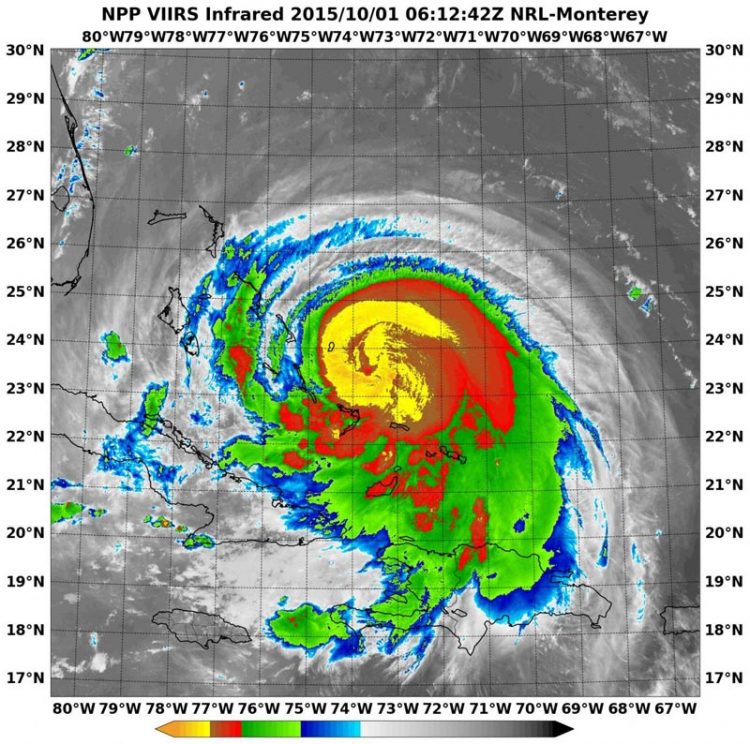Satellites show Joaquin becoming a Category 4 hurricane

NASA-NOAA's Suomi NPP satellite passed over Joaquin at 06:10 UTC (2:10 a.m. EDT) on Oct. 1 as it was strengthening from a Category 2 to a Category 3 hurricane. Imagery showed cloud top temperatures colder than -63F/-53C (yellow). Credits: NRL/NASA/NOAA
The GOES-East satellite is managed by NOAA, and at NASA's GOES Project at the NASA Goddard Space Flight Center in Greenbelt, Maryland, imagery from GOES-East we compiled into an animation. The infrared and visible imagery from September 29 to October 1 from showed Hurricane Joaquin become a major hurricane in the Bahamas.
Earlier in the morning, NASA-NOAA's Suomi NPP satellite passed over Joaquin at 06:10 UTC (2:10 a.m. EDT) as it was strengthening from a Category 2 to a Category 3 hurricane. The Visible Infrared Imaging Radiometer Suite (VIIRS) instrument aboard captured an infrared image that showed cloud top temperatures colder than -63F/-53C, indicative of powerful storms within the hurricane. NASA research has shown that storms with cloud tops that high (and that stretch that high into the troposphere) have the capability to generate heavy rain.
On October 1, a Hurricane Warning was in effect for the Central Bahamas, Northwestern Bahamas including the Abacos, Berry Islands, Eleuthera, Grand Bahama Island, and New Providence, The Acklins, Crooked Island, and Mayaguana in the southeastern Bahamas. A Hurricane Watch was in effect for Bimini and Andros Island, and a Tropical Storm Warning was in effect for the remainder of the southeastern Bahamas excluding the Turks and Caicos Islands and Andros Island.
At 2 p.m. EDT (1800 UTC), the center of Hurricane Joaquin was located near latitude 23.0 North, longitude 74.2 West. Joaquin was moving generally southwestward at about 6 mph (9 kph), and the National Hurricane Center forecast a turn toward the northwest and north on Friday, October 2. On the forecast track, the center of Joaquin will move near or over portions of the central Bahamas today and tonight and pass near or over portions of the northwestern Bahamas on Friday, October 2.
Reports from an Air Force Reserve Hurricane Hunter aircraft indicated that maximum sustained winds have increased to near 130 mph (210 kph) with higher gusts. Joaquin is now a category 4 hurricane on the Saffir-Simpson Hurricane Wind Scale. Some additional strengthening is possible during the next 24 hours, with some fluctuations in intensity possible Friday night and Saturday.
Hurricane force winds extend outward up to 45 miles (75 km) from the center and tropical storm force winds extend outward up to 140 miles (220 km).
The latest minimum central pressure extrapolated from Hurricane Hunter aircraft data is 936 millibars. For effects on the Bahamas, updates to forecasts, watches and warnings, visit the National Hurricane Center website: http://www.
The NHC updated forecast takes Joaquin on a more northerly track from Saturday, October 3 through Tuesday, October 6 toward Long Island, New York. Tracks and forecasts are subject to change.
Media Contact
All latest news from the category: Earth Sciences
Earth Sciences (also referred to as Geosciences), which deals with basic issues surrounding our planet, plays a vital role in the area of energy and raw materials supply.
Earth Sciences comprises subjects such as geology, geography, geological informatics, paleontology, mineralogy, petrography, crystallography, geophysics, geodesy, glaciology, cartography, photogrammetry, meteorology and seismology, early-warning systems, earthquake research and polar research.
Newest articles

Silicon Carbide Innovation Alliance to drive industrial-scale semiconductor work
Known for its ability to withstand extreme environments and high voltages, silicon carbide (SiC) is a semiconducting material made up of silicon and carbon atoms arranged into crystals that is…

New SPECT/CT technique shows impressive biomarker identification
…offers increased access for prostate cancer patients. A novel SPECT/CT acquisition method can accurately detect radiopharmaceutical biodistribution in a convenient manner for prostate cancer patients, opening the door for more…

How 3D printers can give robots a soft touch
Soft skin coverings and touch sensors have emerged as a promising feature for robots that are both safer and more intuitive for human interaction, but they are expensive and difficult…




















